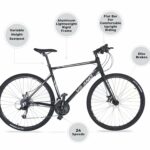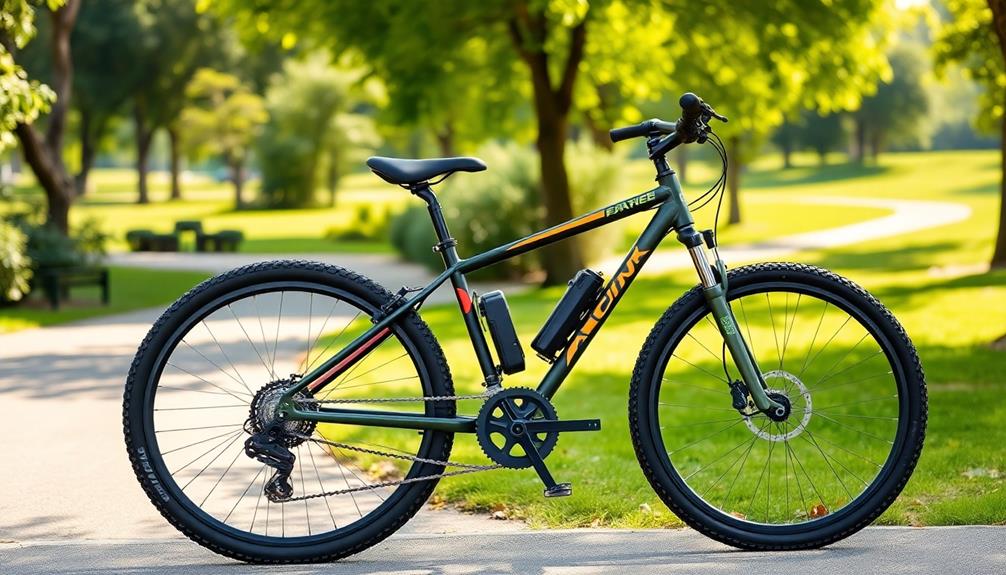A hybrid bike is perfect if you want comfort, versatility, and an upright riding position for city commuting, leisure rides, or mixed terrains. A road bike suits you if you’re after speed, efficiency, and long-distance riding on paved surfaces, with a lightweight, aerodynamic design. To decide, think about where you’ll ride most and your comfort preferences. Keep exploring—more details will help you find the best fit for your cycling needs.
Key Takeaways
- Choose a hybrid for comfort, versatility, and mixed terrains; opt for a road bike if you prioritize speed and long-distance performance.
- Hybrids feature upright frames and wider tires, ideal for casual riding, commuting, and varied surfaces; road bikes have aggressive geometry for efficiency.
- Budget and maintenance preferences favor hybrids with durable, budget-friendly components; high-end road bikes focus on lightweight, high-performance parts.
- Consider your typical terrain: hybrids excel on mixed surfaces and urban environments; road bikes are best on paved roads and racing circuits.
- Prioritize comfort for casual or daily rides with hybrids; choose a road bike for competitive, long-distance, or performance-oriented cycling.
Key Differences in Frame Design and Geometry
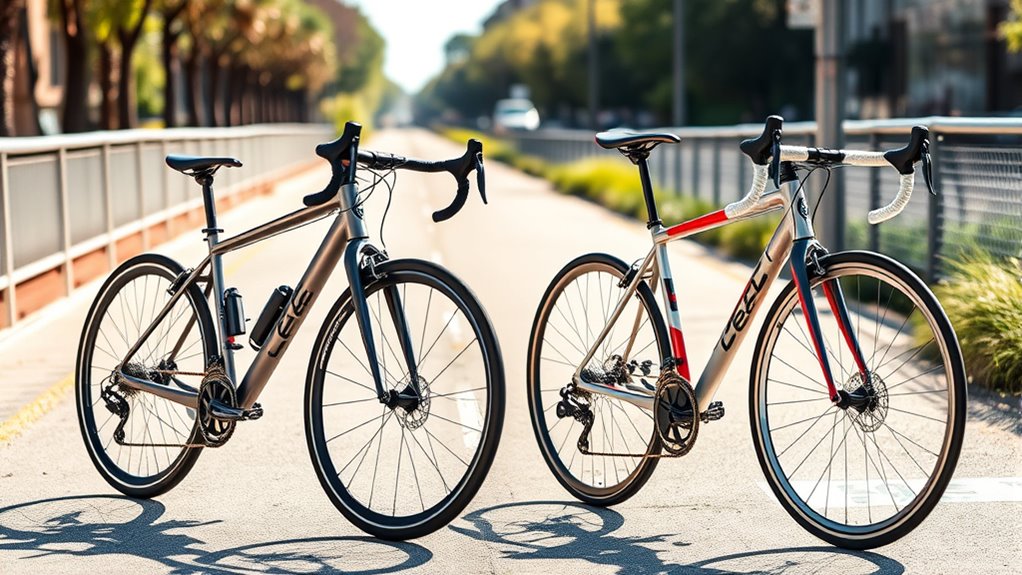
The key differences in frame design and geometry between hybrid and road bikes considerably impact how you ride. Road bikes feature a more aggressive, aerodynamic frame geometry with a longer top tube and a lower handlebar position, designed to boost speed and reduce wind resistance. This creates a forward-leaning riding position that emphasizes speed and agility. In contrast, hybrid bikes have a relaxed, upright frame design with a shorter top tube and higher handlebars, prioritizing comfort and visibility. Their sturdier, heavier frames from steel or aluminum enhance bike stability and durability for everyday use. These geometry differences directly influence your rider posture, with road bikes encouraging a more aerodynamic stance, and hybrids supporting a comfortable, upright riding position suitable for longer, casual rides. Additionally, the frame materials used can affect the overall weight and ride comfort of each bike type. Understanding the bike frame design helps you choose the right bike based on your riding style and preferences.
Tyre Sizes and How They Affect Your Ride
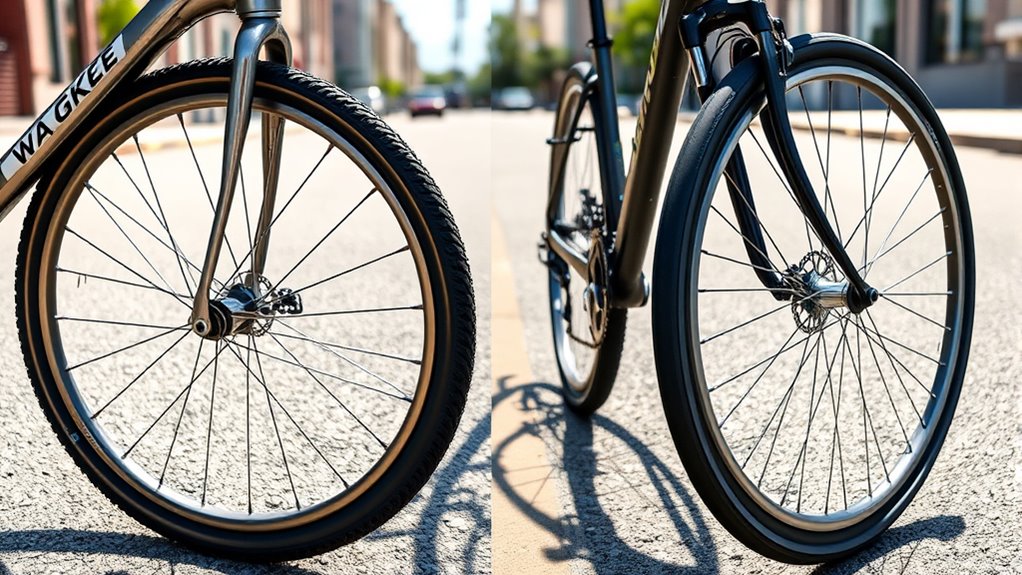
Choosing the right tyre size considerably influences how your bike performs. Smaller tyres, like 25-28 mm, reduce rolling resistance, boosting speed on paved roads, especially on tyres on road bikes with rigid frames. Wider tyres, typically 28-32 mm, offer more tyre clearance, accommodating tyres suitable for various terrains, providing better grip and comfort. Here are key points to *contemplate*:
- Narrow tyres improve aerodynamics but decrease tyre clearance and comfort.
- Wider tyres lower pressure, increasing grip on rough surfaces.
- Tyres and rigid frames are optimized for specific tyre sizes impacting overall performance.
- Tyres and tyre clearance vary between hybrid bikes and road bikes, affecting the bike’s versatility.
- Additionally, the choice of tyre size can influence the overall ride quality, especially when considering home theatre projectors, where image quality depends on proper calibration and setup.
- Understanding how tyre sizes relate to bike frame compatibility can further help you select the most suitable options for your riding style and terrain. Additionally, advances in sound healing science have shown that selecting the right setup can improve your riding experience by enhancing focus and relaxation during longer rides. Moreover, selecting appropriate tyre sizes based on regulatory standards ensures safety and compliance during your rides.
Understanding tyre sizes helps you choose tyres suitable for your riding style and terrain.
Performance and Speed on Various Surfaces

Your tyre size substantially impacts how your bike performs across different surfaces. Narrow tires on road bikes (25-28 mm) reduce rolling resistance, boosting speed and efficiency on paved roads. Hybrids sport wider tires (28-32 mm), offering better grip and comfort on mixed terrain but slightly reducing top speed. The geometry of your bike influences handling and performance: road bikes are aggressive for aerodynamics, while hybrids provide a relaxed stance for off-road comfort. Additionally, choosing the right brewing method can enhance your overall cycling experience by ensuring proper hydration and energy intake during rides.
Comfort and Riding Posture for Different Activities
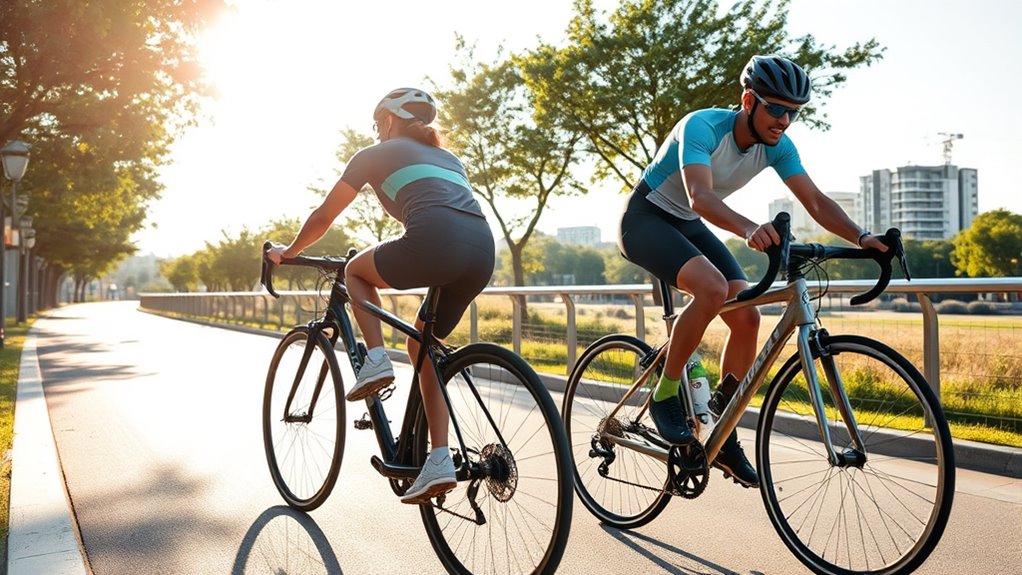
Different activities demand different riding postures to maximize comfort and performance. A hybrid bike’s upright riding position, with higher handlebars and a relaxed seat, provides comfort for casual commuting, sightseeing, or long leisure rides. This posture reduces back strain and keeps you relaxed, ideal for extended periods. In contrast, road bikes adopt an aggressive, aerodynamic riding position with drop bars, engaging core and leg muscles for efficiency in racing or long-distance riding. The riding posture impacts fatigue levels and comfort:
Upright comfort for casual rides; aerodynamic posture boosts performance for racing and long-distance cycling.
- Upright riding posture offers better back and neck comfort for casual activities.
- Relaxed seat enhances overall comfort during extended rides.
- Aerodynamic position reduces wind resistance but can increase back strain.
- Riding activity dictates whether comfort or performance takes priority, influencing your choice of riding position.
- The riding posture significantly affects overall comfort and endurance, especially during longer rides. Additionally, choosing the right posture can prevent strain or injury, ensuring you enjoy your ride safely and comfortably. Proper cycling ergonomics can further optimize your riding experience and reduce the risk of discomfort, especially considering the versatility of hybrid bikes that allow for different riding styles. Incorporating an understanding of bike fit can also help tailor your riding position to your body type for enhanced comfort.
Components, Gearing Systems, and Maintenance Needs
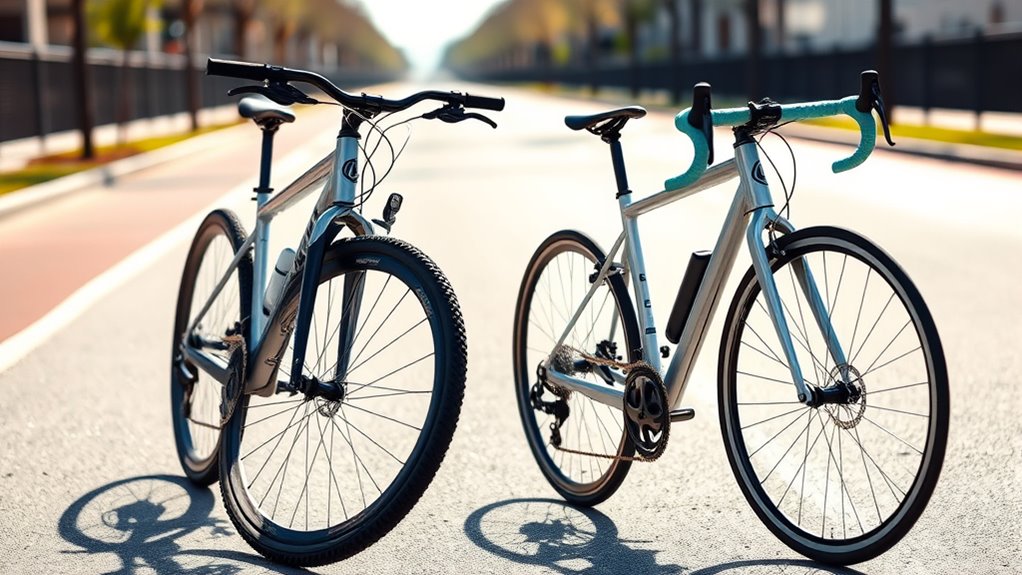
The components and gearing systems of hybrid and road bikes play a significant role in how they perform and how much maintenance they require. Road bikes often feature high-end, lightweight components like Shimano Ultegra or Dura-Ace, designed for speed and efficiency, but they demand more maintenance, including regular cleaning and precise adjustments. Hybrids typically use more durable, budget-friendly components such as Shimano Acera or Alivio, which are easier to maintain. Gearing systems on road bikes usually have fewer speeds with compact chainrings optimized for speed, while hybrids offer a wider gear range with three front chainrings for varied terrain. Many hybrids still use mechanical shifting cables, whereas modern road bikes increasingly adopt electronic shifting for smoother gear changes. Disc brakes, common on both, differ in type: hybrids often have mechanical disc brakes, while high-end road bikes may feature hydraulic systems for better stopping power. Regular inspection of paint sprayer components can help ensure your bike’s gear and brake systems stay in top condition. Additionally, understanding bike maintenance techniques is essential for keeping your bike performing optimally and extending its lifespan. Proper knowledge of drivetrain care can also significantly improve your riding experience and reduce the need for frequent repairs. Crochet kits for beginners can be a helpful way to learn about maintaining and customizing components, especially for those interested in bike repairs and upgrades.
Best Uses and Terrain Suitability

Road bikes perform best on sealed, smooth roads, emphasizing performance and speed. They excel on tarmac, making them ideal for endurance rides and racing. Hybrids, on the other hand, offer greater versatility for mixed terrains, including gravel and light off-road paths. Consider these points: 1. Road bikes perform best on sealed, smooth roads, emphasizing performance and speed. 2. Hybrids handle a variety of terrains, combining durability with comfort for urban commuting and casual rides. 3. For endurance and long-distance rides on paved surfaces, road bikes deliver superior efficiency. 4. Hybrids are suitable for city riding, touring, and light off-road adventures, thanks to their balanced design. Additionally, Ford Tuning techniques can optimize bike performance for specific terrains and riding styles. For example, adjusting gear shifting techniques can help maintain optimal cadence on different surfaces. Choose based on your terrain needs and riding style for maximum enjoyment.
Advantages and Disadvantages of Each Bike Type
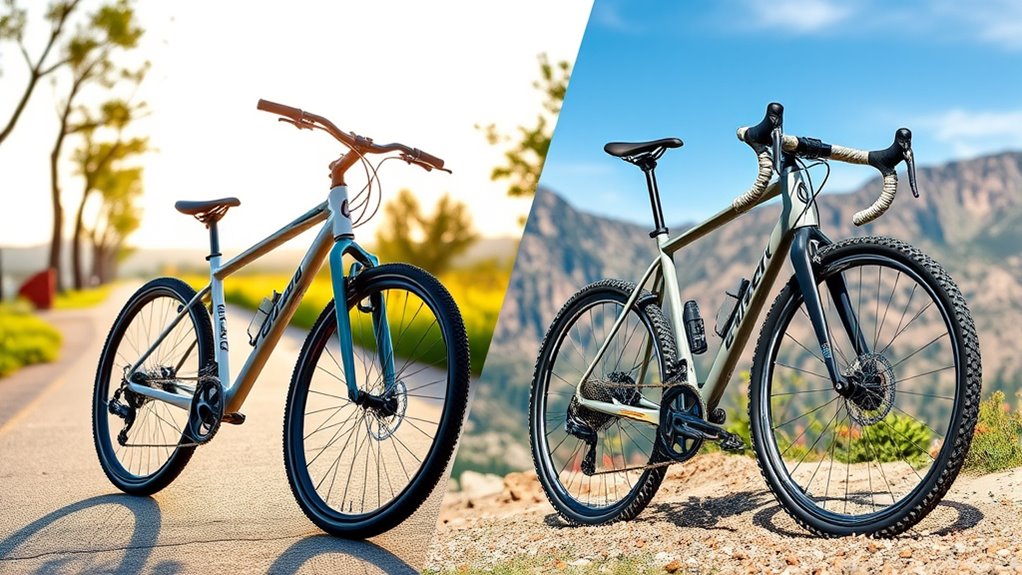
Hybrid bikes excel in providing comfort and versatility, making them ideal choices for daily commuting and casual rides across various terrains. Their upright riding position and wider tires enhance comfort, especially on rough surfaces. However, they trade some speed and handling precision for this comfort. Versatility allows hybrid bikes to adapt to different environments, making them a practical choice for many riders. Additionally, the design of hybrid bikes often incorporates features from both road and mountain bikes, further emphasizing their adaptability. Road bikes prioritize speed and performance with lightweight frames, narrow tires, and aggressive geometry, optimized for paved surfaces. Their components are often high-end and lightweight, boosting efficiency but reducing durability.
Factors to Consider When Making Your Choice
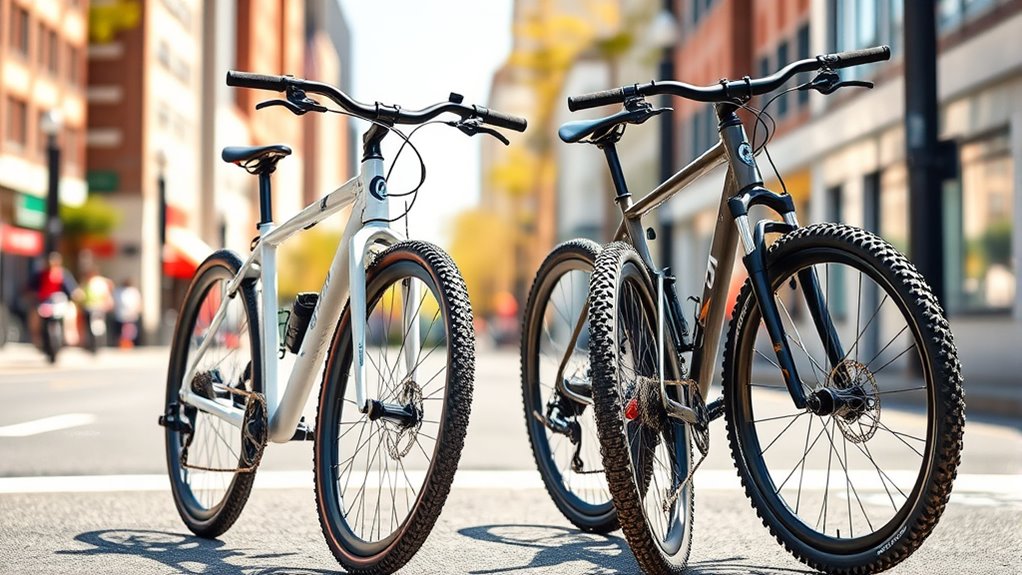
When choosing between a hybrid and a road bike, you need to consider where you’ll ride most often. Think about whether comfort or speed matters more to you, and how much you’re willing to spend on maintenance and components. Making these decisions helps make sure you pick the bike that fits your riding style and budget. Additionally, consider the performance cookies that can help analyze your riding patterns and preferences to make a more informed choice.
Intended Riding Terrain
Choosing the right bike depends heavily on the terrain you’ll be riding most often. Your riding terrain influences whether hybrid bikes or road bikes suit you best. Consider these points:
- For mixed terrains like gravel and pavement, hybrids offer versatility with wider tires and upright geometry.
- If you mainly ride on smooth pavement, road bikes excel with narrow tires and aerodynamic design.
- For off-road or rough terrain, hybrids or gravel bikes provide better stability and tire clearance.
- Long-distance rides on paved roads favor lightweight road bikes that prioritize speed and efficiency.
Your terrain roughness and obstacles shape your bike’s features, impacting comfort, speed, and adaptability. Matching your riding terrain guarantees your bike enhances your experience without unnecessary compromises.
Comfort Versus Speed
Deciding between comfort and speed depends on what you prioritize most during your rides. If comfort is key, a hybrid bike’s upright riding position and cushioned seats reduce strain on your back and neck, making long rides more enjoyable. Its relaxed frame weight and handling provide a smoother, more stable riding experience, especially on urban routes. Conversely, if speed matters, road bikes are designed for aerodynamic efficiency. Their aggressive posture, with drop handlebars, and lightweight frames enable you to ride faster—often 10-20% quicker than hybrids on paved surfaces. Road bikes maximize performance through a more aerodynamic riding position, but this may compromise comfort over long distances. Ultimately, your choice hinges on whether you prefer a relaxed, comfortable ride or a more performance-oriented, speedy experience.
Budget and Components
Budget and component selection play a crucial role in shaping your bike choice. Your budget influences the quality of components and materials you can afford. With road bikes, higher-end components like Shimano Ultegra or Dura-Ace improve performance but increase price and materials cost. Upgrading components later can boost performance, but it involves additional expense and limited upgrade options on hybrids. Hybrids usually have durable, lower-cost materials like aluminum or steel, making them more affordable and easier to maintain. When choosing, consider:
- Component quality and upgrade potential
- Materials used and associated costs
- Durability versus performance needs
- Overall affordability based on your budget
Balancing these factors ensures you select a bike that fits your riding goals without overspending.
Frequently Asked Questions
Should I Get a Hybrid or Road Bike?
You’re wondering whether to get a hybrid or a road bike. Think about your riding style and terrain. If you want comfort and versatility for city commuting or casual rides, a hybrid suits you best. But if you’re aiming for speed on smooth pavement or long-distance rides, a road bike is the way to go. Choose based on what feels most comfortable and aligns with your riding goals.
What Are the Disadvantages of a Hybrid Bike?
Think of a hybrid bike as a sturdy, sluggish turtle in a race, weighed down by its chunky shell. Its heavier frame and wider tires slow you down on paved roads, like trudging through mud. The relaxed position and cushioned seat may feel cozy, but they chop your speed and agility. Plus, the lower-end components demand more upkeep, making it less ideal if you’re chasing quick, smooth rides or racing ambitions.
Can You Get Fit on a Hybrid Bike?
Yes, you can definitely get fit on a hybrid bike. It encourages longer, comfortable rides with an upright position, making it easier to stay consistent. The wide, cushioned seat and adjustable gears help you ride more often without discomfort, boosting your cardiovascular health, muscular endurance, and stamina. Whether you’re a beginner or recovering from an injury, a hybrid bike offers a versatile, low-impact way to improve your overall fitness.
Who Are Hybrid Bikes Good For?
Hybrid bikes are great for you if you want comfort and versatility. They suit commuters and recreational riders who prefer an upright position, making city rides and light off-road adventures enjoyable. If you enjoy running errands, touring, or riding on mixed terrains, a hybrid bike provides the practicality and ease you need. They’re especially ideal if you’re new to cycling, concerned about back comfort, or want a bike that handles diverse conditions.
Conclusion
Choosing between a hybrid and a road bike is like picking the right shoes for a hike or a run—you want comfort, performance, and versatility. Think about where you’ll ride most and what feels best for you. Both bikes have their perks and quirks, so trust your instincts and pick what suits your style. Ultimately, the perfect ride will feel like an extension of yourself, smooth and effortless, ready to take you wherever you want to go.





